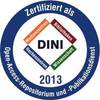In: Acta Radiologica, 66 (2025), Nr. 5. pp. 512-520. ISSN 0284-1851
PDF, English
- main document
 Restricted access: Repository staff only until 4 February 2027. Restricted access: Repository staff only until 4 February 2027.
Login+Download (1MB) | Terms of use |
Abstract
Background Little is known of the influence of scanner field strength on quantitative diffusivity variables, especially kurtosis in healthy ovaries. Purpose To evaluate the influence of scanner field strength on quantitative diffusion variables in pelvic MRI of the ovaries. Material and Methods This prospective, single-centre study consisted of repeated 1.5-T and 3-T examinations in 30 female volunteers (mean age=27.9 years, age range=20.3–45.2 years) from July 2017 to September 2019. Multi b-value DWI 0, 50, 100, 800, 1500, 2000 s/mm 2 was acquired over three timepoints during the menstrual cycle. Ovaries were segmented at b = 1500 s/mm 2 . Median apparent diffusion coefficient (ADC) and advanced kurtosis parameters D app and K app were calculated. Statistical analysis was performed with the variations of diffusivity variables being compared between 1.5-T and 3-T MRI using a Mann–Whitney rank-sum test. Results Median ADC and D app (µm²/ms) did not statistically differ. Median ADC were 1.509 (range=1.371–1.610), 1.619 (range=1.463–1.747), and 1.511 (range=1.423–1.639) at 1.5 T; 1.542 (range=1.428–1.682), 1.658 (range=1.510–1.806), and 1.572 (range=1.455–1.709) at 3 T ( P = 0.14, 0.19, and 0.07), whereas median D app were 2.024 (range=1.913–2.152), 2.192 (range=2.010–2.327), and 2.045 (range=1.958–2.170) at 1.5 T; 2.013 (range=1.952–2.188), 2.179 (range=2.018–2.327), and 2.082 (range=1.959–2.194) at 3 T ( P = 0.77, 0.99, and 0.34) for timepoints 1, 2, and 3, respectively. Statistical comparison of K app revealed significant differences for all timepoints: 0.629 (range=0.595–0.652), 0.604 (range=0.574–0.651), and 0.622 (range=0.581–0.664) at 1.5 T; 0.601 (range=0.563–0.626), 0.567 (range=0.526–0.633), and 0.599 (range=0.541–0.650) at 3 T ( P < 0.001, 0.005, and 0.03). Conclusion Diffusivity mapping in the ovaries provides similar absolute median diffusion values, but statistically significant differences in absolute kurtosis values between 1.5 T and 3 T.
| Document type: | Article |
|---|---|
| Journal or Publication Title: | Acta Radiologica |
| Volume: | 66 |
| Number: | 5 |
| Publisher: | Sage |
| Place of Publication: | London |
| Edition: | Zweitveröffentlichung |
| Date Deposited: | 31 Oct 2025 13:39 |
| Date: | 2025 |
| ISSN: | 0284-1851 |
| Number of Pages: | 9 |
| Page Range: | pp. 512-520 |
| Faculties / Institutes: | Service facilities > German Cancer Research Center (DKFZ) Medizinische Fakultät Heidelberg > Radiologische Universitätsklinik |
| DDC-classification: | 610 Medical sciences Medicine |
| Uncontrolled Keywords: | Genital, reproductive, magnetic resonance diffusion/perfusion, ovaries, adults |
| Additional Information: | Dieser Beitrag ist aufgrund einer (DFG-geförderten) Allianz bzw. Nationallizenz frei zugänglich. *** This publication is freely accessible due to an Alliance licence and a national licence (funded by the DFG, German Research Foundation) respectively. |









